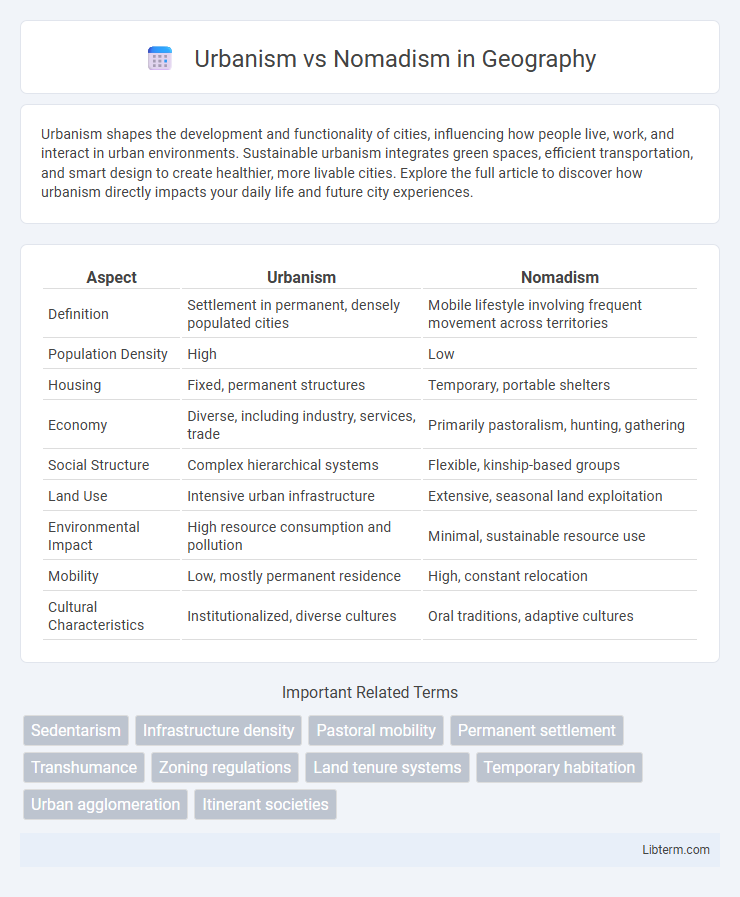Urbanism shapes the development and functionality of cities, influencing how people live, work, and interact in urban environments. Sustainable urbanism integrates green spaces, efficient transportation, and smart design to create healthier, more livable cities. Explore the full article to discover how urbanism directly impacts your daily life and future city experiences.
Table of Comparison
| Aspect | Urbanism | Nomadism |
|---|---|---|
| Definition | Settlement in permanent, densely populated cities | Mobile lifestyle involving frequent movement across territories |
| Population Density | High | Low |
| Housing | Fixed, permanent structures | Temporary, portable shelters |
| Economy | Diverse, including industry, services, trade | Primarily pastoralism, hunting, gathering |
| Social Structure | Complex hierarchical systems | Flexible, kinship-based groups |
| Land Use | Intensive urban infrastructure | Extensive, seasonal land exploitation |
| Environmental Impact | High resource consumption and pollution | Minimal, sustainable resource use |
| Mobility | Low, mostly permanent residence | High, constant relocation |
| Cultural Characteristics | Institutionalized, diverse cultures | Oral traditions, adaptive cultures |
Understanding Urbanism and Nomadism
Urbanism entails the development of densely populated cities characterized by structured infrastructure, diverse economic activities, and complex social networks that foster innovation and cultural exchange. Nomadism emphasizes mobility and adaptability, with communities moving periodically to access resources, maintain ecological balance, and sustain traditional lifestyles without permanent settlement. Understanding these paradigms reveals contrasting human adaptations to environment, social organization, and resource management.
Historical Evolution of Urban and Nomadic Societies
Urbanism and nomadism represent distinct patterns of human settlement shaped by environmental, economic, and social factors throughout history. Early urban societies emerged around fertile river valleys, such as Mesopotamia and the Nile, promoting permanent architecture, centralized governance, and complex trade networks. In contrast, nomadic groups, influenced by pastoralism and seasonal resource availability, maintained mobility across vast landscapes, preserving adaptive strategies that shaped cultural exchanges and territorial dynamics over millennia.
Core Principles of Urbanism
Urbanism centers on the development of densely populated areas with structured infrastructure that supports social interaction, economic activities, and cultural institutions. It emphasizes sustainability, accessibility, and community-oriented design to create livable spaces that foster human connection and efficient resource use. Core principles include mixed-use development, walkability, public transportation, and green spaces to enhance the quality of urban life.
Key Characteristics of Nomadism
Nomadism is characterized by the continuous movement of people who lack a fixed, permanent settlement, relying on seasonal migration for resources and survival. It often involves pastoralism, hunting-gathering, or shifting cultivation, and emphasizes adaptability to diverse environments. Social structures in nomadic groups tend to be flexible and kinship-based, with minimal material possessions and a strong connection to the natural landscape.
Social Structures: Urban vs Nomadic Communities
Urban social structures feature complex hierarchies with specialized roles and formal institutions that manage governance, education, and economic activities. Nomadic communities rely on flexible, kinship-based networks emphasizing egalitarian relationships and collective decision-making to adapt to changing environments. The contrast highlights urbanism's dependence on permanence and infrastructure versus nomadism's mobility and social fluidity.
Economic Models in Urban and Nomadic Lifestyles
Urbanism revolves around concentrated economic models driven by industrialization, service sectors, and infrastructure development, fostering steady job markets and innovation hubs. Nomadism relies on decentralized, resource-based economies emphasizing adaptability, trade networks, and seasonal migration, often focused on livestock, artisanal crafts, and sustainable resource management. The contrast highlights urban economic complexity and scale versus nomadic flexibility and resilience in fluctuating environments.
Environmental Impact: Cities vs Nomadic Movements
Urbanism generates concentrated environmental pressure through high energy consumption, waste production, and greenhouse gas emissions, heavily impacting air and water quality. In contrast, nomadic movements typically have a lower ecological footprint by utilizing mobile, low-impact lifestyles that reduce habitat disruption and resource depletion. However, urban centers offer opportunities for innovative sustainability solutions, such as green infrastructure and efficient public transit systems, which can mitigate environmental damage over time.
Cultural Expressions in Urbanism and Nomadism
Cultural expressions in urbanism manifest through diverse architectural styles, public art, and vibrant street performances reflecting the dense social fabric of cities. Nomadism fosters dynamic cultural practices shaped by mobility, such as oral traditions, craftsmanship, and rituals blending influences from multiple regions. Urbanism emphasizes permanent, collective cultural landmarks whereas nomadism prioritizes adaptable, transient expressions tied to movement and nature.
Challenges Facing Urban and Nomadic Populations
Urban populations face challenges such as overcrowding, pollution, housing shortages, and strain on infrastructure and resources. Nomadic groups encounter difficulties including limited access to healthcare, education, and legal recognition amid increasing land privatization and environmental degradation. Both lifestyles struggle with adapting to climate change impacts and socioeconomic pressures that threaten their traditional ways of living.
Future Prospects: Integrating Urban and Nomadic Approaches
Integrating urban and nomadic approaches emphasizes the development of adaptive infrastructure that supports mobility while maintaining connectivity and access to essential services. Future prospects include smart cities designed with modular housing and flexible workspaces, enabling seamless transitions between stationary urban living and mobile lifestyles. This hybrid model leverages digital technology, sustainable design, and decentralized systems to enhance resilience and social inclusion in increasingly dynamic populations.
Urbanism Infographic

 libterm.com
libterm.com